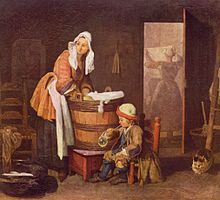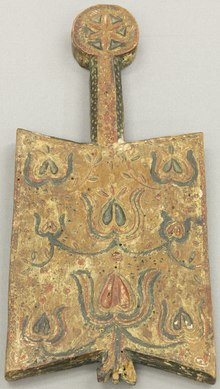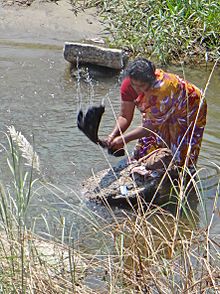Laundry
The word laundry describes both the process of cleaning (washing) textiles in water and a specific group of washable textiles.
Laundry as a washing process


Photo in cabinet size , between 1880 and 1890

The laundry , so the process of washing of textiles , can be done in unterschiedlichster form. Washing by hand (also known as hand washing) has been almost completely replaced by machine washing, i.e. washing in washing machines , at least in the industrialized countries . Exceptions to this are i. d. Usually only hand washing of sensitive textiles. Another form of cleaning in addition to the traditional laundry today, Dry Cleaning . As a rule, a label is attached to textiles on which washing instructions are given in the form of standardized textile care symbols . They also indicate the recommended washing temperature.
Washing machines provide different washing programs for different types of textiles: whites, delicates, coloreds, etc. (the same words are used to denote the respective textiles, see below). With these programs, different wash cycles follow one another: e.g. E.g .: prewash, main wash, rinse, drain, spin.
history
The washing process has changed a lot over the past 100 years. In the first half of the 20th century, the laundry had to be soaked for up to 24 hours, boiled in large kettles and then processed by hand with various tools ( bleuel , washboard , etc.). Those who could afford it used curd or soft soap for delicate items of laundry; But as these were quite expensive, washing was done primarily with soda , which leached the laundress' hands very much. To rinse out the laundry, one often went to the stream or the water pump, as this required a lot of water and the houses often did not yet have their own water connections. Winning the laundry was also very exhausting. White laundry and items with soiling that were difficult to remove were then often bleached in the sunlight, that is, laid out on the "Bleiche", a particularly well-tended meadow, and watered several times with a watering can (in many places street names such as "Auf der Bleiche", etc.) are reminiscent of this custom. ). When exposed to sunlight, the grass develops bleaching oxygen. Because the washing was so laborious, wealthier people often only washed 2 to 3 times a year; common people often had to hold laundry days once a month because they didn't have enough laundry. In the cities there were already washhouses and laundry rooms in which one could wash with warm water. To do this, water was heated in a huge kettle, which is where the name of the laundry “kitchen” comes from. Here, too, the laundry was washed according to the same principle with soap, soda, brush, washboard and bleuel (which, with a longer handle, was also used to stir the laundry in the wash tub ). Hand washing was made easier with the laundry tamper . In the latest models, air and lye were sucked in and pushed through the laundry by a spring-loaded, sieve-like perforated part attached to the bell .
In the first washing machines, an impeller cross was driven by hand with a mechanical lever mechanism. They also didn't have a cooking device. The laundry continued to be cooked in the kettle. The clean laundry was wrung out by means of a roller wringer attached to the washing vessel in order to collect the valuable lye again in the machine. Around 1930 there were also washing machines that were powered by the line pressure via a connection to the water pipe.
The first fully automatic washing machine for private households was introduced in America in 1946. About five years later it found its way into German households. At this time, the first modern heavy-duty detergents came onto the market. The prices for this new product were still so high that only a few bought it. They were not spared the tedious scrubbing and brushing of the laundry. Since the washing machines themselves also had a high purchase price, it was common at that time to lend these devices to households for a day. This practice is still common today in poorer countries.
In the 1970s, the drum washing machine gradually gained acceptance . It made washing a lot easier. Housewives especially had their "fun" with the spin cycle of their new machine - because if the machine was not firmly anchored in the floor, the vibrations made the dishes in the cupboards "dance"; some models also made themselves independent, that is, the machine set itself in motion by the vibrations during the spinning and jerked through the room or even through parts of the house. But some housewives did not quite trust the machine. For this reason, the "porthole" was created, through which you could always keep an eye on the laundry.
Because washing has become so easy, washing is done much more frequently today, so that overall more energy, water and time is used than before.
In 2009 an article published in L'Osservatore Romano became the starting point of a controversy, according to which the washing machine had contributed more to the liberation of women than chemical contraception or the increasing approval of abortion . A study by the Université de Montréal in Canada came up with similar results.
Laundry sign
The marking of laundry items with initials or full name within a household as well as a marking that contract laundries carried out in order to be able to assign the goods to the customer was designated as a laundry mark .
Today, such machine-embroidered laundry signs are mostly used by large companies such as hospitals, hotels and the like. used. The care labels on all textiles sold today are also called laundry symbols.
Laundry as a name for textiles
With laundry and all of the washable fabrics referred, preferably underwear , table linen , bed linen , underwear , etc. As a repository of laundry is in western culture traditional and mostly still the linen closet, the linen chest or closet.
Laundry in the sense of dirty laundry, clean laundry, etc.
In relation to the process of washing, all washable textiles are referred to as laundry. The entirety of the soiled textiles is called dirty laundry. It is collected (usually separated according to the type of laundry) in the laundry basket or laundry buffer. The cleaned textiles are then referred to as "clean laundry".
Differentiation of laundry into colored laundry, whites, delicates etc.
Textiles of different materials and different processing allow different care and washing methods. With regard to the recommended type of laundry, a distinction is made between colored laundry, whites , delicate laundry, wool laundry, etc.
Among whites was wearing fabrics that can be washed at 95 ° C understands. This helps kill microorganisms . These are mainly bed linen , underwear , household linen and work clothes made of cotton , linen or viscose, traditionally mostly white, today at least mostly light. Darker textile dyes would not withstand the high water temperatures and would rub off. Washing program in the washing machine : normal program with low water level and strong drum movement. Detergent : heavy duty detergent. Classic hot laundry uses a lot of energy; Due to the high performance of modern detergents, washing is usually done at 60 ° C instead. However, the term “hot wash” is mostly retained.
Coloreds however, is a generic term for all brightly colored fabrics that are not kochecht or colorfast, so they can not be washed at 95 ° C such. B. bed linen , nightwear , household linen and work clothes. When washing with the washing machine , the name stands for the same program as the whites, only at a lower temperature. The washing temperature can vary from 30 ° C to 60 ° C, the water level is normal and the drum movements are strong and vigorous.
Easy- care laundry refers to textiles that are easy to wash and do not need to be ironed, or only need to be ironed very little. This includes in particular textiles made of synthetic fibers (nylon, Perlon, polyamide) and specially treated natural fibers (e.g. cotton) and mixed fabrics. The fibers generally absorb less dirt, are easier to wash and return to their original shape when dry, so they do not crease badly. Most washing machines have a special wash cycle for easy-care textiles that takes a little less time than the normal cycle. It is also gentle because the mechanical stress in the corresponding wash program lies between whites / coloreds and delicates. To avoid ironing, the washing machine should not be overcharged.
Delicates referred delicate white and brightly colored fabrics, mostly from chemical fibers (synthetic), and curtains . Washing program in the washing machine : "Delicates" - with high water level, half the capacity and reduced drum movement at temperatures from cold over 30 ° C to 40 ° C. Classic men's shirts also allow a washing temperature of 60 ° C. Detergent : mild detergent or, for curtains, special detergent for curtains.
Wool linen refers to white and brightly colored textiles made of silk and wool , mostly sheep's wool ( new wool ). The white flokato carpets belong here as well as the curtains. Unless hand washing is mandatory, the washing program in the washing machine is selected : Wool with a high water level. The drum movement corresponds to about half of the drum movement from “easy-care” - fine, with any drum movement being completely stopped during the heating phase (automatic soaking phase). Wash temperature cold to 30 ° C. Detergent : special detergent for silk, special detergent for wool, and hair shampoo because of its chemical identity.
Laundry in the sense of bed linen, underwear, household linen, etc.
Textiles that are subject to special hygienic or cleanliness requirements are traditionally usually produced as white, boil-proof textiles (bed, night, household, table, underwear, etc.). The third meaning of the word "laundry" refers to these textiles:
The word “laundry” no longer means the entirety of all washable textiles, but rather special types of textiles in contrast to other textiles that are not laundry (outerwear, curtains, upholstery covers, etc.).
Today, such textiles are often made in color (colored bedclothes and underwear) or from non-boilable material (e.g. nylon underwear ), sometimes even from non-washable material (e.g. lingerie ). In the corresponding areas, however, the term laundry is still used.
Idioms
- Since 1930 the phraseological connection looking stupid out of the laundry has been used for a simple-minded, incomprehensible facial expression (cf. WddU p. 906).
- The phrase washing dirty laundry (disapproving of someone else's mistakes) has been used since the 19th century (cf. WddU p. 906).
- Doing someone else's laundry - physically assaulting someone, sexually harassing someone .
See also

- bleaching
- Iron
- Textile care symbol
- Washboard
- Washing machine
- laundry detergent
- laundry
- Laundry disposal system
- Clothes dryer
- Spin dryer
- washroom
- Washing day
- White goods
Individual evidence
- ↑ History of laundry washing, washing bell (laundry rammer)
- ↑ see advertisement for the Superwaschling (PDF; 2.1 MB) in the Hamburger Abendblatt of May 21, 1951, p. 7 bottom right
- ↑ Own experience 1945 ff by author G-Michel-Hürth
- ↑ The first fully automatic washing machine. Retrieved April 22, 2018 .
- ^ Giulia Galeotti: Metti il detersivo, chiudi il coperchio e rilassati ( IT ) In: L'Osservatore Romano . 8. Retrieved July 25, 2011.
- ^ Washer liberated women, Vatican says . Web.archive.org. March 12, 2009. Archived from the original on March 12, 2009. Retrieved October 23, 2013.
- ↑ Chemical-Technical Repertory, Volumes 6-8 . Verlag R. Gaertner., 1867. p. 4
- ↑ Karin Gottschalk: Property, Gender, Justice: Households and Heirs in Early Modern Leipzig . Campus Verlag, 2003, p. 71
- ↑ Washing dictionary, www.waesche-waschen.de ( online )
literature
- Britta Spies, Jutta Nunes Matias: Bathing day and big laundry: dealing with cleanliness , ed. from the Folklore Commission for Westphalia , Landschaftsverband Westfalen-Lippe, Münster-Hiltrup: Landwirtschaftsverl, 2004, ISBN 3-7843-3279-X
- Ursula Groß: Clever washing: protect the environment, save energy, clean allergen-free, care gently , Munich: Ludwig, 2001, ISBN 3-7787-3974-3
- Jean Pütz , Monika Pohl, Rudolf Weber: Hobbythek special - washing clothes with a white vest: environmentally friendly and energy-saving , Cologne: vgs, 2000, ISBN 3-8025-1423-8
- Barbara Orland: Washing clothes - technical and social history of domestic laundry care . Rowohlt Taschenbuch Verlag, Reinbek near Hamburg 1991. ISBN 3-499-17736-6
- Josef Kurz: Cultural history of domestic laundry care - women's work and building services as reflected in the centuries . Wachter-Verlag, Bönnigheim 2006, ISBN 3899042484
swell
- Heinz Küpper: Dictionary of German colloquial language . 1st edition, 6th reprint. Velcro; Stuttgart, Munich, Düsseldorf, Leipzig 1997, p. 906
Web links
- Literature about laundry in the catalog of the German National Library
- Miele Museum in Gütersloh
- The cultural history of washing in the folklore and open-air museum Roscheider Hof




